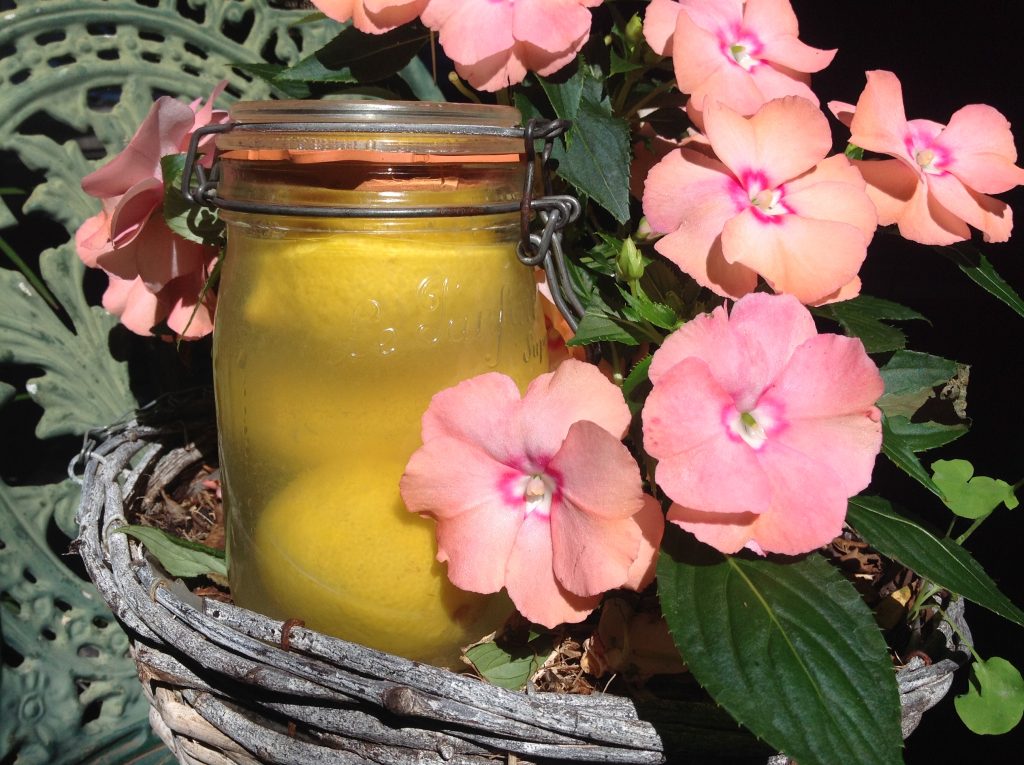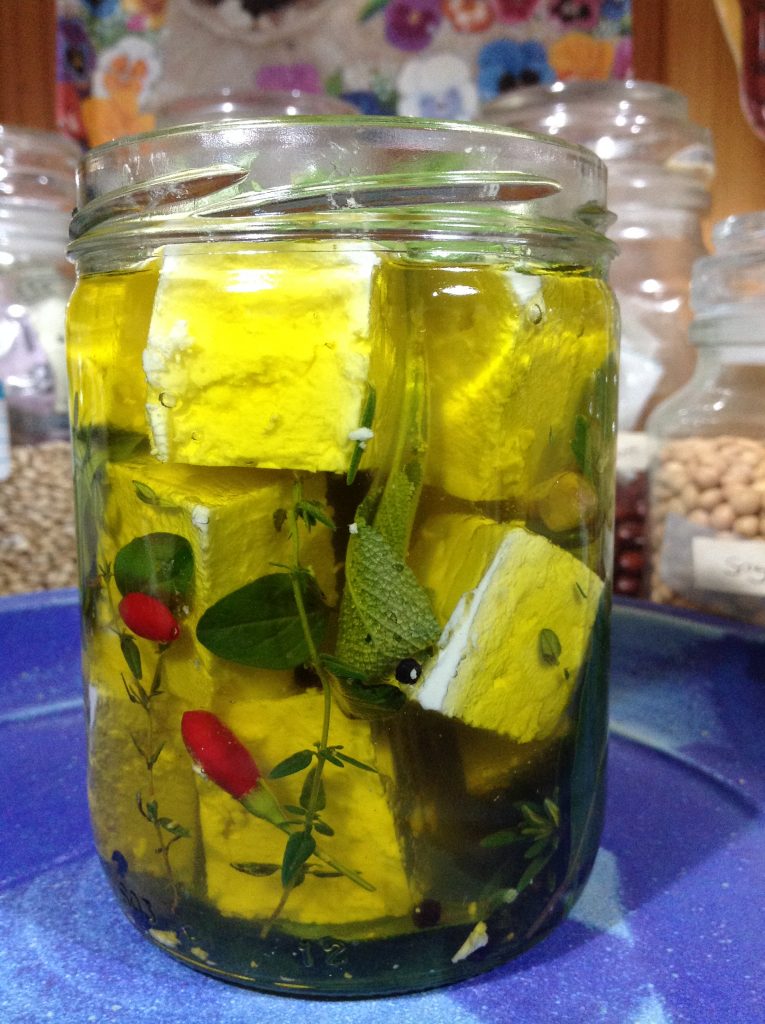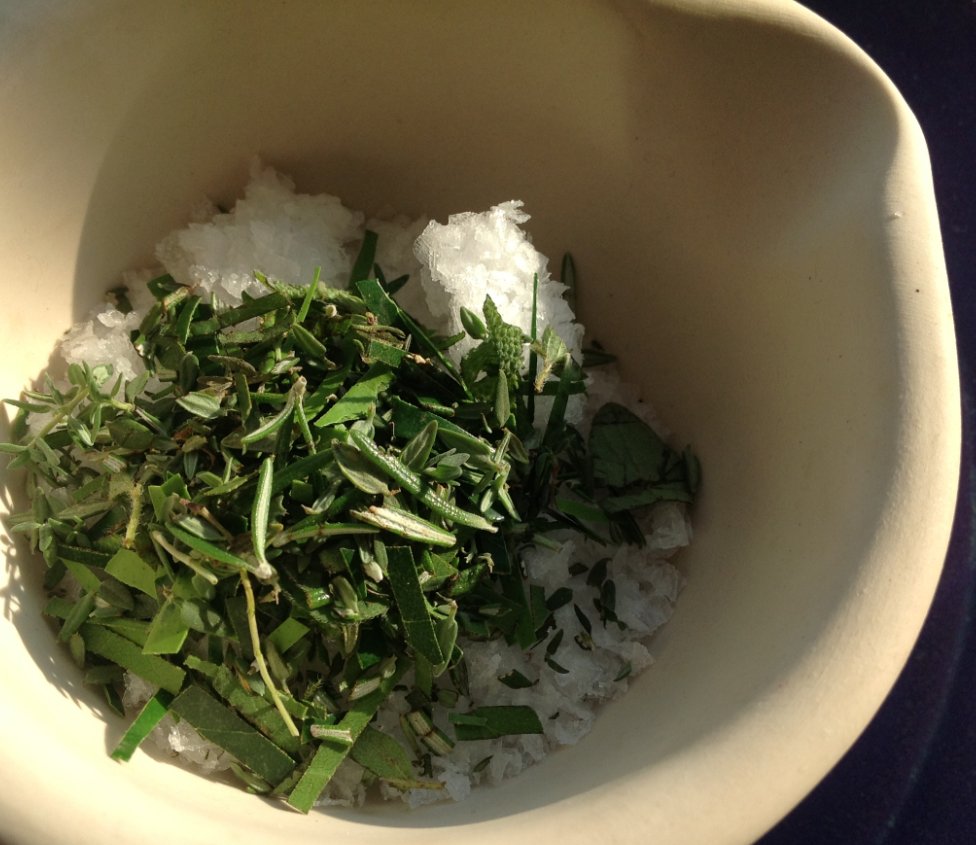We have just returned from staying at Olive’s Cottage in Windermere for several days.
With autumn well under way in Tasmania, the herbs were looking a little ragged and needing trimming while the lemon tree had a handful of fruit that needed to be picked. We were thus prompted to make three items we regularly make at home in Melbourne. We used herbs to marinate some feta as a gift for Launceston friends who had invited us for dinner. We used more herbs to make some aromatic salt to be left behind for guests staying at the cottage. And we salted and preserved three lemons, which we later stored in the storeroom refrigerator to be used during our future stays at the cottage.
The methods/recipes follow.
 Marinated feta or goat’s cheese
Marinated feta or goat’s cheese
Jars of marinated feta and goat’s cheese can be bought in good food stores, but they are easy to produce at home. We won’t give a formal recipe – the method is really based around what is on hand. We use fresh herbs, but dried ones can be substituted.
- You need 100 to 200 g of quality cheese that will maintain its shape when cubed.
- Find a suitable jar with a reasonably wide mouth to hold the cheese. Sterilise if required.
- Prepare a small selection of aromatics and herbs (one or two sprigs of each) from the following list:
– thyme, rosemary, bay leaves, kaffir lime leaves, parsley, sage, oregano, tarragon, black peppercorns, garlic cloves (crushed), chillis (whole or flakes)
- Wash the herbs and dry very thoroughly with paper towel or with a tea towel.
- Pack the jar in a decorative way with the herbs and cubes of cheese.
- Fill the jar with quality olive oil.
This method can also be used for other cheeses: try marinating parmesan.
The oil will take on some lovely flavours and, when the cheese has been eaten, can be used in various ways, especially in salads and pasta dishes.
Aromatic salt
Some years ago, friends returned from France with a gift of a small grinder filled with herb infused salt. It came from Hédiard, the luxury food store in Paris. It probably cost them a ‘bomb’. We enjoyed the salt in many ways: sprinkled over sandwiches, eggs, salads and lightly flavoured dishes. Eventually the small Perspex grinder was empty but a strong wrist and twist of the top showed it could be unscrewed and refilled, something we have now done dozens of times.
Plastic grinders filled with salt are widely available now through supermarkets and food stores. We provide one at the cottage for guests. On our latest trip to the cottage, the grinder was almost empty so we replaced it with a brand new one and made a bottle of aromatic salt from the empty one and left it for guests.
Like the marinated feta, the method is really based around what is on hand. Again, we use fresh herbs, but dried ones can be substituted. (Some fresh herbs, like parsley, may be too wet, causing the salt to take on moisture and clog.)
- You need rock salt with small to medium sized grains or salt flakes.
- You need a suitable grinder – a see-through one is ideal, but a salt grinder made from wood or other material will give the same taste result.
- Prepare a tiny selection of ‘dry’ herbs from the following list.
– thyme, rosemary, bay leaves (rib removed, cut into tiny strips), kaffir lime leaves (rib removed, cut into tiny strips), sage, oregano, tarragon, chilli flakes
- Wash the herbs and dry very thoroughly with paper towel or with a tea towel. Note: any moisture on the herbs may cause the salt to clog.
- Chop the herbs roughly.
- Combine the salt and herbs and pack into the grinder.
It seems a waste to use aromatic salt in cooking – just use it as a condiment!
Preserved lemons
In the last two decades, preserved lemons have made their presence felt largely through Moroccan recipes. Jars of one to three preserved lemons can be purchased, however, they are easy to make at home with the addition of just salt, lemon juice and water. A link to our preferred method follows.
The lemons need to be soaked for several days before bottling.
This photo is of newly bottled lemons – the juice will be cloudy initially but eventually it will settle down and clarify.
 For the recipe, click here: Preserved Lemons
For the recipe, click here: Preserved Lemons
Contributions welcomed!
If you have any preserve-like items you regularly make, we are happy to hear about them, including the ingredients and why they are worth doing.




